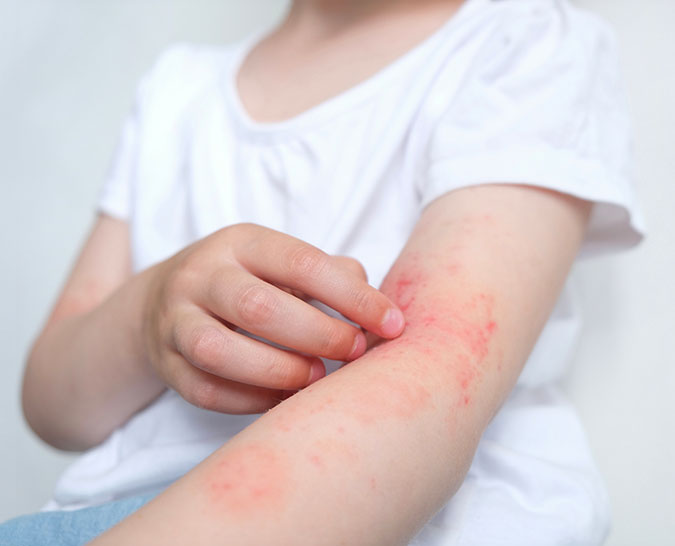Atopic Dermatitis (AD) is a chronic skin disease linked to genetic variations affecting skin protection. It usually begins in infancy and can extend into adolescence and adulthood. While there is no cure, treatment and self-care measures can alleviate itching and prevent new outbreaks.
Atopic Dermatitis (AD) is a chronic skin disease linked to genetic variations affecting skin protection. It usually begins in infancy and can extend into adolescence and adulthood. While there is no cure, treatment and self-care measures can alleviate itching and prevent new outbreaks.
Healthy skin helps retain moisture and provides protection against bacteria, irritants, and allergens. Atopic Dermatitis (AD), also known as atopic eczema, is a chronic inflammatory skin disease that often exacerbates with periodic flare-ups. Eczema is linked to a genetic variation that affects the skin’s ability to provide this protection, leading to skin being affected by environmental factors, irritants, and allergens.
AD predominantly begins in infancy, starting at 2 to 6 months of age, and can extend into adolescence. Most patients outgrow AD during these stages, but about 5-10% continue to have eczema in adulthood or experience a relapse of symptoms after several years without them.
AD is a multifactorial disease resulting from the interaction of genetic factors, environmental influences, defects in barrier function, and a series of immunological factors. It often presents in families with atopic diseases (atopic dermatitis, bronchial asthma, and/or allergic rhinoconjunctivitis), making it one of the most common skin diseases. In some children, food allergies can influence the onset of eczema.
It is estimated that the prevalence of AD in adults ranges between 2-5% (according to studies), and it predominantly occurs in mild-moderate forms (only 0.08% present severe AD). The severity of AD is based on considering the erythema, infiltration, excoriations, and the extent of the affected areas.
The signs and symptoms of atopic dermatitis vary widely from one person to another and include the following:

While there is no cure for atopic dermatitis, treatments and self-care measures can alleviate itching and prevent new outbreaks.
Here are some recommended measures:
- Hydration: Keep your skin moisturized by using emollient creams, ointments, or lotions 2 or 3 times a day to maintain skin moisture. With the help of your pharmacist, choose one or several suitable products for you.
- Triggers: Try to identify and avoid triggers that worsen the condition. Some factors that worsen symptoms include:
- Bathing: When washing or bathing, keep in mind:
- Avoid scratching: Although it may be difficult, breaking the itch-scratch cycle will prevent lesions from worsening. Use moisturizers, topical corticosteroid creams, or antihistamines as prescribed. Keep your nails well-trimmed. Use soft gloves when sleeping if night scratching is a problem.
Current treatments are recommended based on the severity of AD and its complications. An optimal treatment for AD should not only improve clinical signs such as reducing skin inflammation and improving its barrier function but also improve the disease burden. Therefore, when choosing a treatment, not only objective medical evaluations of disease severity should be considered, but also the subjective evaluation of patients. Assessing patient satisfaction with their treatment is crucial to increase adherence and ultimately reduce the disease burden.
The following treatments should always be administered under medical prescription and for the indicated time. The usual treatments for managing AD are:
- Hygiene Measures: As explained in the previous Prevention section, proper personal care is the first measure for mild cases of AD.
- Moisturizing Creams: Moisturizing creams, protective creams that contain ceramides.
- Topical Corticosteroid: Low-medium potency topical corticosteroid to control itching and help repair the skin. They should be applied following the instructions after moistening the area. There are different types of corticosteroids whose choice depends on the patient’s age, the extent of the lesions, and their morphology.
- Topical Immunomodulators: Such as calcineurin inhibitors (topical tacrolimus and pimecrolimus) for patients from 2 years of age, especially if they do not respond after applying topical corticosteroids. They act on the immune system to help control skin reactions. Apply them following the instructions after moistening the area. Avoid intense sunlight when using these products.
- Topical Antibiotics: In case of having a bacterial infection in the skin, an open ulcer, or cracks. They may even prescribe oral antibiotics for a short period to treat the infection.
- Oral Antihistamines: For the control of itching or allergies. Depending on the type of antihistamine, sometimes to take advantage of its sedative effect for nighttime rest. Topical antihistamines should not be used.
- Phototherapy: Takes advantage of the anti-inflammatory effect of solar radiation. This treatment is used in people who do not improve with topical treatments or who present a rapid exacerbation after treatment. The simplest form of phototherapy (light therapy) consists of exposing the skin to a controlled amount of natural sunlight. Other forms use artificial ultraviolet A (UVA) and narrow-band ultraviolet B (UVB) light alone or with medications. It should be noted that it is not indicated in children under 12 years except for exceptions.
- Systemic Treatments: Oral medications to control inflammation for the most severe cases.
- Other Therapies for Atopic Dermatitis
Remember, managing Atopic Dermatitis is a journey, not a destination. With the right care and treatment, you can live a comfortable life.